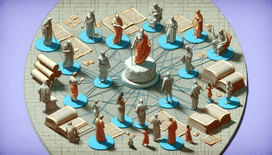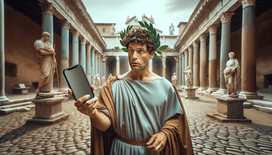Ah, the Black Plague. A spectre that haunted Europe in the 14th century with all the subtlety of a runaway elephant in a porcelain factory. Spreading faster than a juicy piece of gossip at the local tavern, it wiped out nearly a third of Europe’s population at its fiercest, leaving behind a trail of despair, turmoil, and missed matchmaking opportunities. But what if these medieval mortals had access to something as delightful and modern as dating apps?
A Swipe to Remember
Picture this: the year is 1347. London’s streets are buzzing with merchants, bakers, and the occasional troubadour shouting half-audible rhymes about knighthood and lost chicken legs. Amidst the humdrum of Middle Ages mundanity, a new fascination emerges, the ‘Pestilent People Pouncer’, a primitive albeit innovative dating app designed to flourish where the plague had failed to entertain. While it might have dodged the iOS compatibility badge, this app promised to forge connections amidst contagion.
“Swipe left for scoundrels, swipe right for saviours!” might have been its catchy tagline. Boasting the miraculous ability to find your soulmate while maintaining a strict five-foot-barrier, the pre-SMP (Standard Medieval Pestilence) version of social distancing.
Shelf-life of Chivalry
Imagine a world where knights and damsels in their brightly coloured garbs, as smitten as smote, flirt their way through pandemic woes. As each swipe graced their fingertips, these cyber sirs and digital dames would make decisions more vital than choosing between chainmail and full plate armour.
Medieval peasants would eagerly craft profiles, highlighting their finest assets (all thirteen sheep and a culinary résumé including multi-grain gruel). Noble software delivered Cupid’s convolution, a ‘Quarantine Compatibility’ algorithm that not only assessed economic balance but also plague-resistant genetic robustness.
A Match Made Under Minted Weather Vanes
The app's potential to metamorphose social interactions stands unrivalled. Imagine ye olde gatherings, now boasting ‘Masked Mixers’ and ‘Jousting Jointures’, where hopefuls could partake in socially distant rapture with fellow romantics without the risk of being eradicated by mere proximity.
And because it wouldn't be medieval matchmaking without a bit of drama: what innocent swiping session would be complete without the classic mishap, accidentally confusing the Blacksmith Baldwin for the Earl of Fromage? Expectedly, swollen egos rivaled the magnum opus of medieval fashion, the codpiece.
The King’s Preferred Plot
If you think the upper echelons of society would abstain from such digitised dalliances, think again! King Edward III, no stranger to elaborate courts, mattress at meetings, and dubious machinations, would have happily employed our romantically revolutionary app. He could envisage strategic marriages to strengthen alliances against common pests, both plague and peer-related.
Queen Philippa, a tech enthusiast in her own right, would perhaps settle disputes around dowries with a tap and swipe, estimating wealth with eerie precision and orchestrating matches deemed politically sound.
All for One Plague and Plague for All
By injecting fun into the miserable morass of medieval life, dating apps could have played an unorthodox role in galvanizing essential human connections when they were needed most. Who knows? Perhaps a timely ‘super like’ from a neighbouring duchy would have inspired counsel as well as companionship, delivering the much-needed morale boost in a year darkened by disease.
In this alternate reality, the plague would still have struck as fiercely as ever, but each swipe, each match, each medieval meme was a sweet reminder that love, even in a time of plague, is nothing short of endearing folly.
So next time you fancy a flirt on your modern app of choice, think of those medieval souls who danced on the peripheries of a love pandemic, centuries before the time. Perhaps you, dear reader, might have been one of the lucky ones, swiping right in 1347.







